The following article is to describe step by step the 1/18 scale Lockheed Martin F-16CJ Fighting Falcon Block 52, currently flying with Hellenic Air Force, conversion using the BBI - Elite Force toy model kit, bought from the States a couple of years before for less than $60.

Despite my enthusiasm when I finally got this 1/18 model in my hands, as soon as I opened the box which exceeds in length the 3 feet (!!!), I realized that I would face hard time and massive scratch building and I'd need to spend hundreds hours on my hobby bench to make it look descent. In the substance, it is not even a model to assembly but a game for children which could be ready in less than 2 minutes. The detail convinces only if you look the model from a distance while points such as landing gear system, engine nozzle, panel lines etc are real dramatic. Luckily, the model is accurate on dimensions and could possibly be used as a F-16 exhibit model that do not interest on conformity of colors, special details etc.


So, I decide to begin the building from the zero and give life in this 82cm long monster with no detail (comparing to scale models by Hasegawa, Tamiya etc) but however this 1/18 F-16 toy has almost unlimited possibilities of becoming a high detailed scale model. It should be noticed that the model's airframe comes straight from the box already sealed and I had to open it and work it from inside. That's a hard work to do, because the fuselage remains stuck with internal reinforcing possessors and metal supports & screws that I should locate and carefully remove without causing any damage on plastic material.

82cm long beast, immediately after opening of packing box. I am already start thinking about finding the proper window to place this Falcon
By selecting heavy metal on my CD player (in order to I become aggressive and get the "Friday 13th" feeling) and using a saw and a Dremel tool, I opened the fuselage, the basic airframe pieces were cut and useless parts such as landing gear, engine nozzle, a part of the air intake etc were removed and led to the garbage.

























































































































